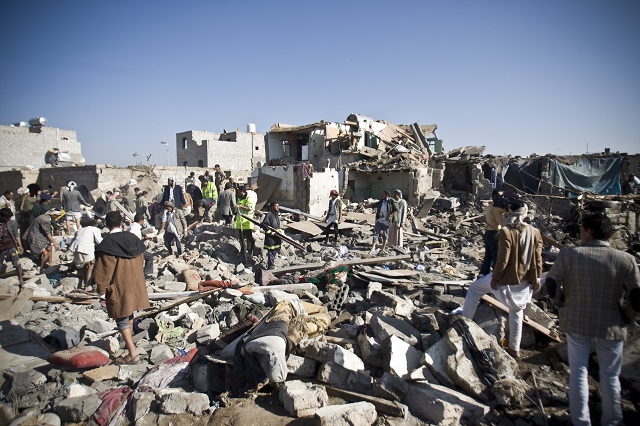The U.S. Just Bombed Yemen, And Everyone's Silent

NEW DELHI: A huge development took place in Yemen recently and went almost entirely unnoticed. The United States -- in what is the country’s first direct involvement in the war in Yemen -- fired a barrage of cruise missiles at three radar sites controlled by the rebel Houthi movement.
The repercussions of this are significant, as it drags the US -- which has thus far limited itself to drone strikes and backing the Saudi coalition in aerial bombardments -- directly into a prolonged and escalated conflict.
Yet, the development has found no space on front page news headlines or TV bytes. The US defended the escalation as “retaliation” -- as last week, the Houthis had fired at a US navy destroyed off Yemen’s coast. The missiles didn’t hit, falling into the water, but it was enough for the US to respond with a clear and decisive measure of escalation.
Additionally, there is another development concerning the US’ role in Yemen that has gone unnoticed and underreported. On October 8, a 500lb laser-guided US-made bomb was dropped on a funeral procession by the US-sponsored Saudi-led coalition fighting the rebels. The bomb killed more than 140 people, mostly civilians, and wounded another 525 people. Human Rights Watch called the incident an “apparent war crime.” “While military personnel and civilian officials involved in the war effort were attending the ceremony, the clear presence of several hundred civilians strongly suggests that the attack was unlawfully disproportionate,” a statement by HRW reads.
“After unlawfully attacking schools, markets, hospitals, weddings, and homes over the last 19 months, the Saudi-led coalition has now added a funeral to its ever-increasing list of abuses,” said Sarah Leah Whitson, Middle East and North Africa director.
Photos and video footage taken after the attack show charred and mutilated bodies strewn in and outside the hall, the building destroyed, and rescuers carrying out bodies to ambulances. One witness said, “When I got there, there were more than 50 burned bodies, many where you can still tell the features, but half of their body was gone, half of their head was gone, but the others, it was very, very hard to tell who they were.”
Hundreds of those killed and wounded were civilians, according to the United Nations Office of the High Commissioner for Human Rights (OHCHR). One witness said that he personally knew at least 45 civilians who had been killed in the attack. At least 20 high-ranking officials affiliated with former president Ali Abdullah Saleh’s General People’s Congress and the Houthis, also known as Ansar Allah, as well as military and security officials, were at the funeral, and several were among the casualties. The Saudi Arabia-led coalition began an aerial campaign against the Houthis and allied forces in March 2015.
Under the laws of war, an attack is unlawfully disproportionate if it may be expected to cause incidental loss of civilian life or damage to civilian structures that would be excessive in relation to the concrete and direct military advantage anticipated from the attack. Only military personnel and civilian officials involved in military operations against the coalition would be considered legitimate targets.
Serious violations of the laws of war committed willfully – that is, intentionally or recklessly – are war crimes. The date and place of the funeral ceremony was announced on Jalal al-Rawishan’s Facebook page on October 7, and would have been publicly available. The afternoon hour of the attack would have been known to be the “peak time” when the funeral ceremony, open to the public, would have been very crowded. Coalition forces should have known that while a number of high-ranking commanders would be gathered, any attack on the hall would result in massive civilian casualties.
Coalition sources initially denied responsibility for the attack, but the following day the coalition announced it would investigate the incident with support from the US.
Since March 26, 2015, the Saudi-led coalition of nine Arab countries, with direct military support from the US and assistance from the UK, has conducted numerous unlawful attacks in Yemen. Human Rights Watch has documented 58 unlawful airstrikes causing civilian loss of life and property. Other human rights organizations, as well as the UN, have documented dozens more. The Houthis and their allies, including forces loyal to former president Saleh, have also committed numerous serious abuses.
Between March 2015 and October 2016, 4,125 civilians had been killed and 7,207 wounded in Yemen, according to OHCHR, the majority by coalition airstrikes. OHCHR reported in August that airstrikes had been the “single largest cause of casualties” over the past year.
It is worth noting that in backing the Saudi coalition, the US supplies $110bn worth of arms since President Obama assumed office, and recently approved the sale of $1.15bn more. The US also supplies the Saudis with necessary intelligence and logistics to prosecute its war.
And while the US and world media is preoccupied with the face off between Donald Trump and Hillary Clinton -- the crucial question of the country’s role in Yemen is not only unanswered, but the news regarding it is pushed to the back.



